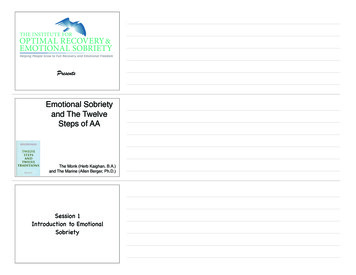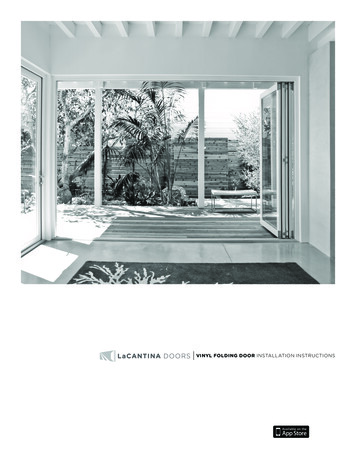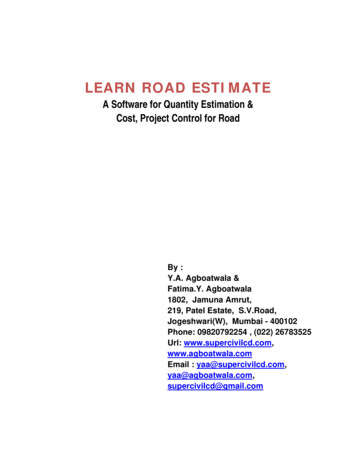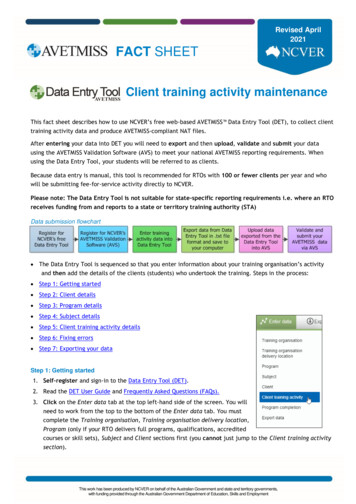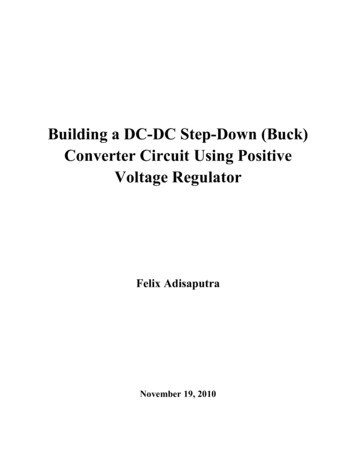
Transcription
Building a DC-DC Step-Down (Buck)Converter Circuit Using PositiveVoltage RegulatorFelix AdisaputraNovember 19, 2010
Executive SummaryVoltage regulator is one type of electrical regulators that provides the ability to maintainthe voltage at the constant level. It is also capable of stepping-up, stepping-down, and invertingthe input voltage supply. Voltage regulator also utilizes the negative feedback control loop.Some designs of voltage regulator can isolate output voltage from the input. In this applicationnote, the LM7809 3-Terminal 1A Positive Linear Voltage Regulator will be used for building aDC-DC step-down (buck) converter circuit.Keywords: voltage regulator, positive voltage regulator, linear voltage regulator, DC-DCconverter, step-down converter, buck converter.
IntroductionVoltage regulators are commonly found in the power supplies as they play a major role tostabilize the output DC voltages. The operation of the voltage regulators basically by comparingthe actual output voltage with the internal fixed reference voltage and utilize the negativefeedback control loop in order to increase accuracy and reduce the error.The LM7809 is a positive voltage regulator that is made by Fairchild Semiconductor. It isa positive linear voltage regulator with three terminal pins. Unlike switching voltage regulator,positive linear voltage regulator only has the functionality of stepping-down (input voltage mustbe greater than the output voltage). This particular voltage regulator has limiting output current,short circuit and thermal shut down protection.Figure 1 below is the block diagram of LM7809 that illustrates the implementationprocess of each element inside the voltage regulator.Figure 1: LM7809 Block Diagram.This LM7809 voltage regulator typically is set to have 11V-17V input and will step itdown to 9V output. The maximum output current that this voltage regulator can draw is 1A.However, under normal condition, the current that flows through the voltage regulator should notexceed 500mA.
ObjectivesThe primary objective is to build a simple circuit of DC-DC stepping-down (Buck)converter. With the LM7809 positive voltage regulator, it is expected to have about 11V-17VDC input stepping-down to 9V DC output. And the secondary objective is to be able to achieveoutput voltage that is stabilized at its level. This stabilization performance should be done by thevoltage regulator.IssuesThe final circuit of the DC-DC step-down (Buck) converter would have additionalelectronic components other than the voltage regulator itself. Some components are capacitorswith capacitance value that are not common. Also, it is expected to have some heat issueconsidering a very low tolerable current value that can flow through the voltage regulator.StepsBelow is the picture of the LM7809 pins orientation and representation,Figure 2: LM7809 pins orientation and representation.
The circuit for the DC-DC step-down (Buck) converter would have the LM7809 voltageregulator, two capacitors with capacitance value of 0.33µF and 0.1µF. Figure 3 below shows thecorresponding circuit,Figure 3: DC-DC step-down (Buck) converter circuit.Step 1: The LM7809 voltage regulator is placed in the desired position on the circuit board.Figure 4: LM7809 is placed on the circuit board.
Step 2: Connects pin 1 of the LM7809 to the ground through 0.33µF capacitor.Figure 5: 0.33µF capacitor is added to the circuit.Step 3: Pin 2 of LM7809 is connected directly to the ground with short wire.Figure 6: Connection between pin 2 of LM7809 and ground.
Step 4: Connect pin 3 of the LM7809 to the ground through 0.1µF capacitor.Figure 7: 0.1µF Capacitor is added to the circuit.Step 5: The DC voltage source (11V-17V) is connected to the circuit on the input end.Figure 8: DC input voltage is supplied.
Step 6: The DC output voltage is ready to be connected to the load.Figure 9: DC output voltage is connected to the load.
ExamplesOne application is demonstrated below, where a computer power supply is used as thevoltage source to power up the LEGO NXT Brick. The computer power supply has 12V DCoutput and the LEGO NXT Brick requires 9V to fully operate. The LM7809 circuit is thenapplied to step-down the voltage from 12V to 9V. Figure 10 below shows the final set-up toobtain this application.Figure 10: Power up LEGO NXT Brick using computer power supply as voltage source.Figure 11: Power supply provides 12V DC and ground.
Figure 12: Closer look of the circuit to LEGO NXT Brick connection.Hardware/Software DevelopedThere are only common electrical components are required for the hardware point-ofview. The LM7809 is one of the most important components in the step-down (Buck) convertercircuit along with the 0.33µF and 0.1µF capacitors. Some wires are also required for the input,output, and ground connection. As for the software concern, there is no need for any software tobe developed to achieve the outcome of the circuit. The LM7809 voltage regulator does not havethe microcontroller element that needs to be programmed to perform the stepping-down voltageconversion.ResultsAs results, the LM7809 step-down circuit has excellent precision for its output voltage.Some measurements have been done for the particular application that is described above, theoutput voltage of the LM7809 step-down circuit is 8.9642V DC, when it is supplied with 12VDC computer power supply. Compared to 9V, it is calculated to be 0.39% error. Furthermore,with appropriate measurement, the output voltage also found to be stabilized very well, as itsoutput voltage value seemed fairly steady. For the output current of the corresponding circuit, itis measured to be 69.296mA.
ConclusionsIn conclusion, the step-down (Buck) converter circuit had been successfully built usingthe LM7809 positive voltage regulator. Based on the measurements that are performed, the stepdown circuit was able to convert the higher DC input voltage (11V-17V) to 9V DC outputvoltage. The LM7809 voltage regulator was also able to stabilize the resulting DC outputvoltage, as it was determined to have reasonably steady value.RecommendationsAlthough the LM7809 voltage regulator performed the step-down converter circuit quitewell, there is a potential problem that might occur in the long run. The case of the LM7809voltage regulator was quite hot when it only draws 1/10 of its output current limitation. This heatissue could be a major problem if the voltage regulator is required to draw more power out of it.Attaching an appropriate heatsink could be a suitable option to solve this heat problem.However, in the LM7809 datasheet, there is another explanation of how to build a high currentvoltage regulator.Figure 13: High Current Voltage Regulator CircuitThis high current voltage regulator circuit requires additional electrical components such as apower transistor and a resistor. The final circuit also seems to be more complicated.
ReferencesLM7809 Positive Voltage Regulator Datasheet http://www.fairchildsemi.com/ds/LM/LM7805.pdf Gasperi and Hurbain, Extreme NXT, Extending the LEGO MINDSTROMS NXT to the NextLevel. 2007.
The circuit for the DC-DC step-down (Buck) converter would have the LM7809 voltage regulator, two capacitors with capacitance value of 0.33µF and 0.1µF. Figure 3 below shows the corresponding circuit, Figure 3: DC-DC step-down (Buck) converter circuit. Step 1: The LM7809 voltage regulator is placed in the desired position on the circuit board.
